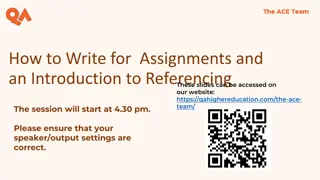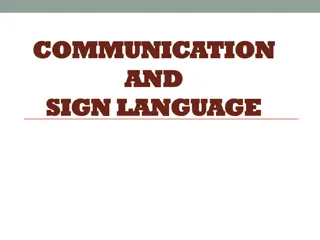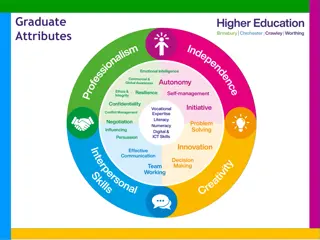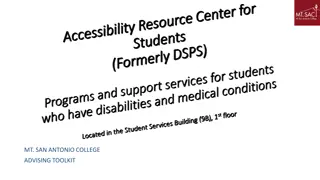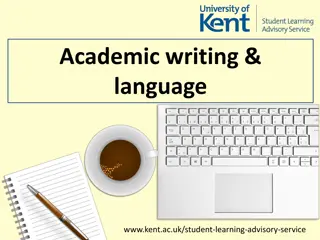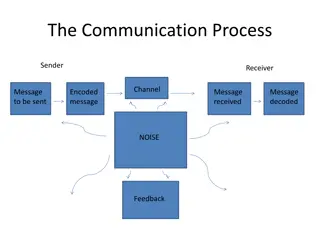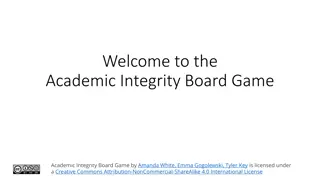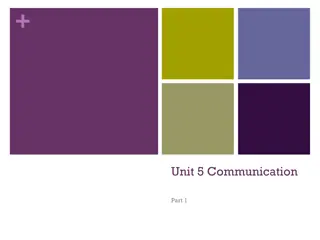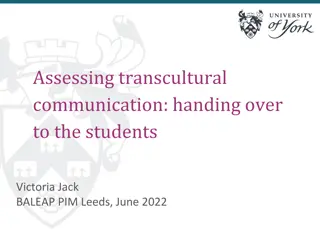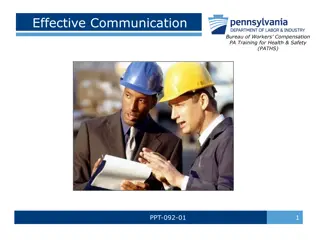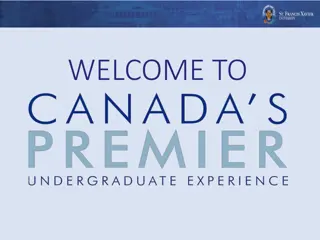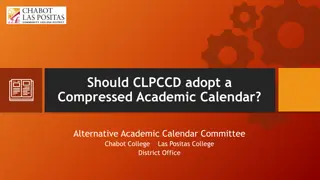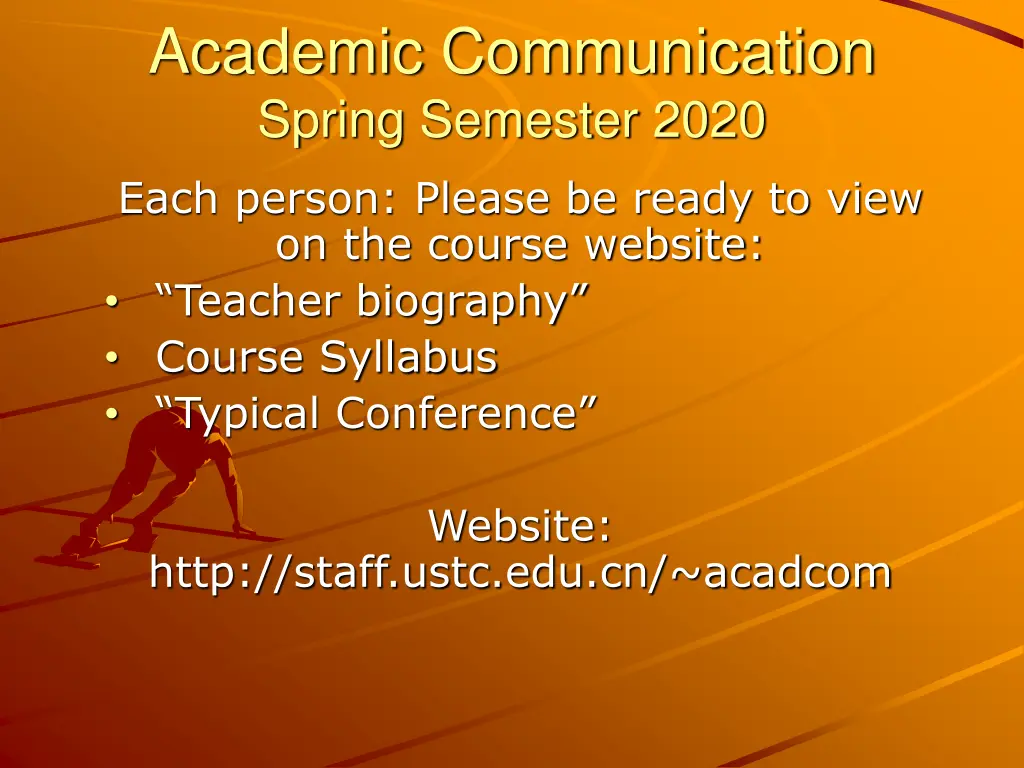
Develop Oral English Skills for Academic Communication
This course in Academic Communication for the Spring Semester 2020 focuses on developing students' oral English skills necessary for presenting research papers at international conferences. The course is conducted online via Zoom and includes activities, teacher biographies, syllabus sheets, and pair work. Access course materials and participate in online lessons through the provided course website.
Download Presentation

Please find below an Image/Link to download the presentation.
The content on the website is provided AS IS for your information and personal use only. It may not be sold, licensed, or shared on other websites without obtaining consent from the author. If you encounter any issues during the download, it is possible that the publisher has removed the file from their server.
You are allowed to download the files provided on this website for personal or commercial use, subject to the condition that they are used lawfully. All files are the property of their respective owners.
The content on the website is provided AS IS for your information and personal use only. It may not be sold, licensed, or shared on other websites without obtaining consent from the author.
E N D
Presentation Transcript
Academic Communication Spring Semester 2020 Each person: Please be ready to view on the course website: Teacher biography Course Syllabus Typical Conference Website: http://staff.ustc.edu.cn/~acadcom
The AC Course This Academic Communication (AC) course is normally taught in the classroom. Spring 2020 things are different so course will start as online course. Will be using the online videoconferencing tool called Zoom . Click on the link on the course website to attend your lesson.
How to Participate in Lessons Go to the course website http://staff.ustc.edu.cn/~acadcom Click on the Zoom link beside your teacher s name to start Zoom and attend the class. Keep the browser window open!: Zoom window to see teacher and lesson PPT Browser window showing course website to see handouts for activities. Switch between these windows to see what you need to see.
Pair Activities As part of lessons, you ll do activities with a partner. Pair work is done in Zoom s breakout rooms , set up by teacher. While in the breakout room, look on the course website for the handout for that activity. If you want to, download the sheet or handout and print it out before class.
Teacher Biography Activity Before talking about the course, let s find out who the teacher is! Go to the Teacher biography activity part of Lesson 1 on the course website. Click on your teacher s name to see the activity information. Be ready to view the information when the teacher puts you in your breakout room with your partner.
Syllabus Sheet This is a handout on the website. Download it now or later. Most of what is on it is also on these slides.
Online Teaching USTC teaching specialists are working to help students learn this material in the current situation where classroom lessons are not possible. Classroom lessons possible before the end of semester? Meanwhile, online version of the course. We will use the internet videoconferencing system called Zoom (unless Zoom doesn t work well enough, in which case we ll switch to another system)
Purpose This course is designed to help students develop the oral English skills necessary to present research papers using English at an international conference.
Teachers Hepuni Kayina (hkayina@ustc.edu.cn) Jamie George (email to be announced) John Gandy(jdg@ustc.edu.cn) Murray Sherk (msherk@ustc.edu.cn) Office hours (via Zoom for now) by appointment arrange a time by email to your teacher.
Textbook No textbook. We will use handouts. For online teaching, get the handouts in electronic form from the course website. Note: Save all handouts since some are used more than once. A handout you get one week may be used again weeks later.
Teaching Methods Course focus = Presentation Skills organization delivery visual aids ... so students learn how to present a scientific paper in English using a typical international style
Classroom Policies Traditional Classroom Format: 24 sections (=groups of students) of this course: Attend the one you are registered for! (except to make up for a missed class) Attendance is required. Students who miss more than two lessons (4 classroom hours) will not be allowed to take the final exam. Being late 1-10 minutes counts as missing half a lesson Being late >10 minutes counts as an absence Spring 2020 exceptions are possible because of technical problems due to online teaching
Online Class Policies 24 sections (=groups of students) of this course: We re not yet sure how to handle attendance but it is still required! Make sure you view each lesson. Best way: Attend the lesson in a Zoom session at the regular class time. Alternate way if technology fails: View the recorded Zoom lesson later.
Classroom Policies (for when we are able to meet in classrooms) International conference standards of behavior will be expected in class. In particular, students should be on time for classes (just as they should be for international conference sessions) phones should be silent during class time (You are welcome to use them as dictionaries, but do not text/phone during class)
Class Policies (continued) Students are expected to cooperate willingly Your learning experience will be more productive if you use only English while in the classroom And while in the Zoom breakout rooms doing activities for the online course
Evaluation End of the term: simulated conference Each student will present a paper in his/her research area (9 minutes) and then answer questions from the audience (3-4 minutes). Your presentation counts for 90% of your term grade. The other 10%? For handing in your transcript after your presentation If classroom teaching has not resumed in time, USTC will make alternate arrangements for you to do your exam presentation.
Physical & Online EPC Sessions The USTC graduate school requires you to attend 20 hours of sessions at the English Practice Center (EPC) on East Campus. Groups of 14 Time to practice English conversation Supervised by a foreign teacher Various topics choose what you like Sign up for sessions online http://epc.ustc.edu.cn How will online EPC sessions work? See the EPC website for information. We hope to use Zoom again.
Needed to pass this course: 20 EPC 20 40 EPC 2 26 3 2 epc.ustc.edu.cn oral practice platform EPC http://epc.ustc.edu.cn
Course Schedule 9 Classroom or Online Lessons: Starting the week of March 2, 2020 Original Plan: Simulated Conference (Oral Exams) April 20 to June 19 (approximately) 6 students per session You will be in ONE exam session You present a paper and you are an audience member for the other students in your session Hand in your transcript (worth 10%) at the end of your session Same time/place as your classroom lessons, spread over 7 weeks after the 9 lessons end. Online Course plan: To be determined if physical classes have not resumed in time.
Which paper will you present? Before Lesson 3, choose the paper you will present for your final exam. For the third class of this semester, you need an electronic version, photocopy, or print-out of the paper you choose. Choose wisely! Bad choices result in more work for you and/or a lower grade.
Which paper? Rules Choose it from a journal issue dated 2014 or more recently. Aim for 2017 or newer. The paper must be about a specific research result that is in your research area was never published before this paper It must not be a general summary/overview of progress in an area. It must not be a simple introduction to an area or previously-known technique.
Which paper? Rules Since you have only 9 minutes to present the result, do not choose a result that is extremely complicated or long. You may choose to present only one result of a paper that has several. Note: You may change your mind later! (But good choice your class work applies directly to your final exam presentation.)
Danger Signs If the title of the paper contains any words like the following, then it is a BAD paper and you should choose a different one! Summary of , Recent Progress in Overview of Introduction to Review of If every scientific result in the paper has already been published in another paper, then it is a BAD paper for this course.
Goals of This Course 1. Good speakers will get better Everybody can learn a bit more 2. Bad speakers will get good enough (for a conference) Pay attention to the techniques taught They do work!!!
Goals of This Course 3. You will know what to aim for What are you trying to do? Clear goals Professional attitude 4. You will know what mistakes to avoid Common mistakes ruin good talks
Types of Scientific Presentations We ll consider four: Conference Presentation Colloquium Seminar Your Exam
Seminar Colloquium Conference Presentation Your Exam! Length Audience Purpose
How long is the presentation? Typically Conference: 20 minutes Colloquium: 60 minutes Seminar: 60 minutes
Seminar Colloquium Conference Presentation Your Exam! Length 60 minutes 60 minutes 20 minutes Audience How many people? Who? What scientific background? What research area? Why am I giving this talk? What do I have for each type of person I expect in my audience? Purpose
Seminar 60 minutes Audience: 10-20 experts in your research area They know all the background Purpose: Explain details of your new result in your research area
Seminar Colloquium Conference Presentation Your Exam! Length 60 minutes 60 minutes 20 minutes Audience 10-20 Experts in your area Purpose Explain details of your result
Colloquium 60 minutes Audience: 50-150 experts in your research field, but not many from your specific research area Most do not know all the background E.g. Profs and grad. students in a department Purpose:
Seminar Colloquium Conference Presentation Your Exam! Length 60 minutes 60 minutes 20 minutes Audience 10-20 Experts in your area 50-150 Experts in your field; most not in your area Purpose Explain details of your result
Colloquium 60 minutes Audience: 50-100 experts in your research field, but most all experts in your area Purpose: Explain recent progress in your research area to people from other research areas.
Seminar Colloquium Conference Presentation Your Exam! Length 60 minutes 60 minutes 20 minutes Audience 10-20 Experts in your area 50-150 Experts in your field; most not in your area Explain recent progress in your area Purpose Explain details of your result
Conference Presentation 20 minutes Audience: 100-600 (A) experts in some area close to your area (how close depends on how narrow the conference is) (B) some experts in your particular area (perhaps world-famous experts!)
Seminar Colloquium Conference Presentation Your Exam! Length 60 minutes 60 minutes 20 minutes Audience 10-20 Experts in your area 50-150 Experts in your field; most not in your area Explain recent progress in your area 100-600 Experts in an area (A) close to yours, or (B) exactly yours Purpose Explain details of your result
Conference Presentation 20 minutes Audience: 100-600 experts in some area (A) close to yours or (B) exactly yours. Purposes: For (A): Give enough information so experts in other areas know basically what the result is and why they might want to read the paper. For (B): Summarize key points of your new result so experts in your area understand it. Give away the good stuff.
Seminar Colloquium Conference Presentation Your Exam! Length 60 minutes 60 minutes 20 minutes Audience 10-20 Experts in your area 50-150 Experts in your field; most not in your area Explain recent progress in your area 100-600 Experts in an area (A) close to yours, or (B) exactly yours Purpose Explain details of your result (A) Basic info: WHAT [the result is] and WHY [it is worthwhile] (B): Summarize key points so experts can fill in the blanks
Your Final Exam Length: 9 minutes [+4 for question & answer] Audience: 5 grad students + teacher experts in some research area but probably not yours Purpose: Convince teacher that you can present a research result well in English at an international conference
Seminar Colloquium Conference Presentation Your Exam! Length 60 minutes 60 minutes 20 minutes 9 minutes Audience 10-20 Experts in your area 50-150 Experts in your field; most not in your area Explain recent progress in your area 100-600 Experts in an area (A) close to yours, or (B) exactly yours 5 + 1 Treat like conference audience Purpose Explain details of your result (A) Basic info: WHAT [the result is] and WHY [it is worthwhile] (B): Summarize key points so experts can fill in the blanks Convince teacher that you can present research well in English (=PASS!)
Preparation for a Conference (Handout sheet, pair activity) One student looks at Version A; the other at Version B (other side of sheet) Do not look at your partner s side of the sheet! By reading out loud and/or asking questions, fill in the blanks on your sheet. Best way: Ask intelligent questions like The call for papers goes out how many months before the conference?
Homework Think about what makes a presentation good, and what makes one bad. Wow, that was a great presentation! Why was it good for you? What made it great ? Terrible presentation a waste time! Why was it bad for you? No need to write anything down Just come to class ready with your idea.


